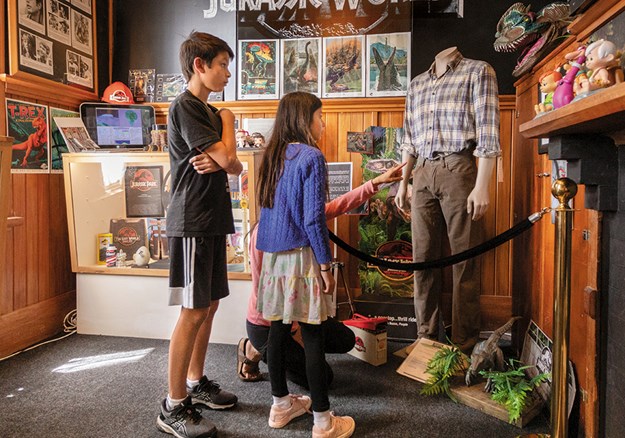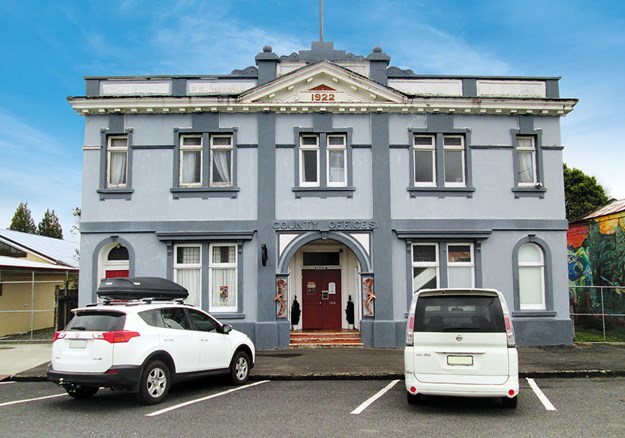Jill Malcolm discovers some unlikely residents in a small North Island town
In mid-March this year returning citizens and foreigners arriving from abroad were still required to isolate before joining the community. One exception to that rule and causing quite a stir was a newcomer of very large proportions, whose body parts entered the country from China through Singapore, contained in several separate crates. It’s improbable, of course, that a seven-metre long Brachiosaurus made of fibreglass would be a Covid-19 spreader. The new arrival was bound for Raetihi, to become the latest addition to an astonishing and unexpected museum known as Dinosaur House. Here it joined five other dinosaurs in the museum’s garden.
Driving down the main street of that unprepossessing little central North Island town – 11km west of Ohakune – it was so incongruous to be promised a gathering of dinosaurs in Raetihi’s old County Building that checking it out was unavoidable.
I am very pleased I did. Inside was a riveting collection of dinosaur displays and enough information to fill a book about those bizarre creatures that roamed the earth for 165 million years – a figure I find impossible to get my head around.
But it’s easy to understand how Ian Moore – who with his wife Sarah, is the brains behind the venture – might have had dinosaurs roaming his head since he was a young boy.
“My obsession with these long-extinct animals is hard to explain,” he says. “The whole subject of dinosaurs – their evolution, existence and extinction as well as the stories of their modern discoveries – is exciting and ever-changing. When I was a boy there were 20 known species of dinosaur. Now some 50 years later, over 1000 have been identigied – large, small, feathered, scaled, herbivores and carnivores.”
 |
|
The costume worn by Sam Neill in the movie Jurassic Park 3
|
CREATING THE MUSEUM
Two years ago, this enthusiasm led to a dramatic change in lifestyle for Ian, Sarah and their four children, when they moved to Raetihi from Auckland, where Ian had worked at Media Works for the last 17 years.
“I’d had the idea of a museum for many years. Ten years ago, I bought the old Raetihi County Offices Building knowing I would make it happen sometime. It’s a perfect venue but it needed a lot of attention.”
Visitors stepping inside the stately building today are introduced to a long-lost world by the 116 models, skeletons, embryos, replica skulls and fossils of some of these extraordinary species that once roamed the earth. All are comprehensively explained and two are animated.
Although Brachiosaurus is large, it is by no means the largest. The heftiest dinosaur found to date is not at the museum and probably never will be. Argentinosaurus, a herbivore, was a gentle giant, 35 metres long and 24 metres tall.
The museum’s largest resident, before Brachiosaurus arrived, does not appear gentle at all. A huge, toothy, scary-looking Spinosauraus leers down from the ceiling in the front room. It was ‘born’ in Kuala Lumpur, where it was made out of foam. So was the Tyrannosaurus rex, displaying his fearsome teeth – the largest of any dinosaurs’ – with a bite-power of 10-30 tonnes.
 |
|
The stately 1922 building where the museum is now housed
|
PAST AND FUTURE SCIENCE
An impressive amount of information is packed into this small museum.
Outstanding was the replica of a developing embryo that Ian calls a ‘chickenosaurus’. In 2003, researchers found that the proteins in a T. rex fossil were similar to those of modern-day chickens. At Harvard, scientists tried to reverse a chicken embryo to that of its ancestor by altering a few genes. They were amazed when the result produced an embryo with many similarities to a dinosaur. It is now thought highly possible that similar engineering could reverse evolution to create a living dinosaur. That sounds like Jurassic Park in real time, and I found the idea much scarier than the Spinosaurus.
The accounts of uncovering these mysteries are as interesting as the animals themselves. Among the stories detailed in the museum is the drama of two 19th-century pioneer palaeontologists, Edward Drinker Cope and Othniel Charles Marsh. In their intense quest to find and name new dinosaur species they became fierce rivals and resorted to bribery, theft and destruction in attempts to discredit one another. The feud brought them financial and social ruin, and yet they uncovered many more specimens than they might have had they been mates.
 |
|
Ian Moore with one of his beloved replica skeletons
|
NEW ZEALAND SPECIES
Earth once teemed with dinosaurs. New Zealand was thought to be exempt until a self-taught palaeontologist, Joan Wiffen, discovered tell-tale fossils in 1975 and later, in a Hawke’s Bay riverbed, a vertebra of one of the largest known species. It belonged to a planteating goliath called a titanosaurid, which almost certainly lived in New Zealand about 80 million years ago. Since then, she and her team have discovered fossil bones from six more dinosaur species.
Dinosaurs dramatically disappeared 65 million years ago. Most scientists agree that the extinction was caused by a catastrophic event, probably when a massive asteroid crashed into Earth.
I could go on. Anyone who has read this far will recognise that I have been converted. I’ve become a dino-junkie and Dinosaur House must take the blame.
Dinosaur House is open from 10am to 4pm every day except Monday.






